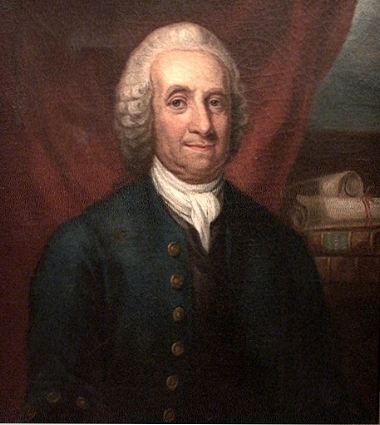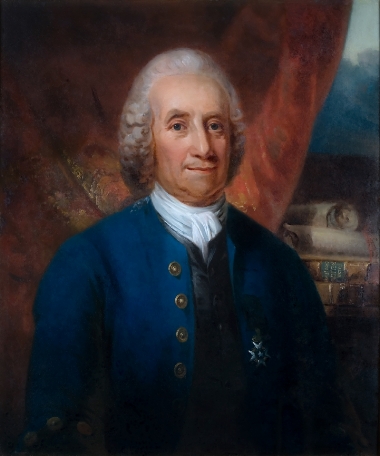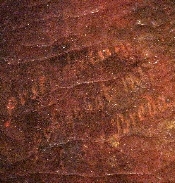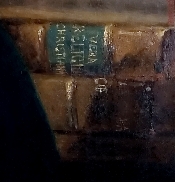A "New" Old Portrait of Emanuel Swedenborg
Ed
Gyllenhaal
Glencairn
Museum News 28.1 (2006): 5–7.
This painting of Swedenborg by noted Swedish portrait artist Carl Fredrik von Breda (1759–1818) was recently "rescued" from storage, cleaned by a conservator, and examined by an art historian. What was discovered in the process surprised everyone involved. Photo: David Hershy, Lasting Expressions Photography. Click on image for a larger version. (Glencairn Museum number 06.OP.75)
These days, most mid-sized museums don't have the funds available to add objects of great historical significance to their collections. However, sometimes a museum can make a great "addition" to its collection by researching, restoring, and appreciating anew an object in its own storage rooms. Such is the case with a 189-year-old oil painting of Emanuel Swedenborg by one of Sweden's great portrait artists, recently "rediscovered" in storage at Glencairn Museum.
Knowledge about this early Swedenborg portrait has faded into obscurity over the years. For a long time it could be seen hanging in one of the buildings on the Academy of the New Church campus. Unfortunately, at some point the entire surface was drenched in water, the result of a leak from above. Moisture caused the exterior layer of varnish to blanch, obscuring the paint layer with a white coating and preventing an exact assessment of its condition. To all appearances, the painting was damaged beyond repair. No longer fit for public display, in 1984 it was accessioned as part of Glencairn's New Church art collection, where it has been preserved in a storage room ever since.
Interest in the painting was reawakened in 2003 when a similar 19th century portrait of Swedenborg was donated to the Glendale New Church in Ohio. The pastor, Rev. Clark Echols, contacted Glencairn Museum, and it soon became apparent that the similarities between the "Ohio Swedenborg" and the "Bryn Athyn Swedenborg" were more than mere coincidence. Dr. John Wilson, an art historian with expertise in 19th century paintings, examined the two side by side, and confirmed that the Ohio version, made in the first half of the 19th century, was a copy of the one in Bryn Athyn.

This 19th century portrait (artist unknown), apparently a copy of the original von Breda at Glencairn Museum, was donated to the Glendale New Church in Ohio by William E. Stilwell III and Katy Kern. For many years it hung in a General Convention church in Cincinnati. It lacks the Order of the Polar Star and exhibits three "extra" buttons. Another copy of the portrait, now in a private collection, was made in 1886 by Evelyn Plummer, a member of the Academy of the New Church.
In the fall of 2005, the Academy's painting was taken to an expert conservator for a preliminary examination. The conservator recommended that, (1) the exterior varnish be removed to reveal the painting's original texture, (2) areas of repainting be reduced or removed, and (3) a fresh layer of conservation-quality varnish be applied. Dr. Wilson and the museum staff agreed with the conservator that this was the best course of action. Our hope was that the painting would "clean up well"—perhaps even well enough to be placed back on public view—and that we would learn more about its history in the process.
We were not disappointed on either count. As it turned out, nearly all of the damage had been to the exterior varnish, and not to the paint beneath. Once the varnish was removed, an intact oil painting emerged with rich colors and a level of detail we had never expected. An artist's signature, date, and inscription became clearly visible on the left side of the painting: "Post obitum pingebat 1817 C.F. v. Breda" (i.e. "Painted after death 1817 Carl Fredrik von Breda"). Other details uncovered when the damaged varnish was removed include the names of several books written by Swedenborg in the background and a dusting of white wig powder on his right shoulder.
When the damaged varnish was removed, the artist's signature, date, and inscription became visible on the left side of the painting: "Post obitum pingebat 1817 C.F. v. Breda" (i.e. "Painted after death 1817 Carl Fredrik von Breda"). Click on image for a larger version.
After cleaning, the names of several books written by Swedenborg became visible in the background. Click on image for a larger version.
After removing an area of repainting, a special insignia, the Order of the Polar Star (Nordstjärneordern), appeared on Swedenborg's chest. Click on image for a larger version.
The conservation of this painting has also raised some baffling questions. The conservator had suggested that several areas of repainting be removed from the surface. When this was done, three of the buttons on Swedenborg's blue coat disappeared, and a special insignia, the Order of the Polar Star (Nordstjärneordern), appeared on his chest! Exactly when and why the three bottom buttons were added, and by whom, is not known. (They were obviously present when the portrait was copied by the painter of the 19th century "Ohio Swedenborg," as that version shows six buttons instead of the original three.) And why was the Order of the Polar Star, an important feature present in von Breda's original portrait, later painted over? As we will see, there may be a straightforward answer to the latter question. However, while a great deal is known about von Breda's artistic career, almost nothing is known about the history of his portrait of Emanuel Swedenborg.
Carl Fredrik von Breda (1759–1818) was a Swedish painter who studied at the Royal Academy of Fine Arts in Stockholm in the late 1700s, specializing in portrait painting. He was also active in England, where he studied under Sir Joshua Reynolds, the foremost English portrait artist of the 18th century. When von Breda returned to Stockholm he was made a professor at the Royal Academy, and was ennobled in 1812. Exactly how he came to paint Swedenborg (forty-five years after the theologian's death, and one year before his own) is not known. Undoubtedly the portrait was commissioned by a client, but the identity of the client, and the story of how it came to America, has been forgotten. Early individuals who compiled lists of Swedenborg portraits—Rudolph Tafel (1877), James Hyde (1906), and Alfred Stroh/Johan Hultkrantz (1910)—were aware that von Breda had painted a portrait of Swedenborg, but none of these sources mention its whereabouts. The Swedish Portrait Archives in Stockholm can find no record of the Bryn Athyn portrait, and it was not included in Emil Hultmark's definitive book about the artist published in Stockholm in 1915 (Carl Fredrik von Breda: Sein Leben un sein Schaffen). Most likely the painting is completely unknown in Sweden, and was brought to America within two or three decades of its completion, at which point it was copied by the painter of the "Ohio Swedenborg." The earliest record found so far of the von Breda portrait as belonging to the Academy of the New Church dates to 1969. Readers of this article who have information about when the Academy acquired this painting, or who know anything about its whereabouts before 1969, are encouraged to contact the editor.
As for the mysterious "painting out" of the Order of the Polar Star-now once again clearly visible on Swedenborg's blue coat-there is at least a partial answer. There is no doubt that the insignia shown on the von Breda portrait (a silver Maltese Cross with a five-pointed star in the center) is the Order of the Polar Star. The King of Sweden himself awarded this order to recipients for "civic merits, for devotion to duty, for science, literary, learned and useful works and for new and beneficial institutions." However, while readers of this newsletter may agree that Emanuel Swedenborg deserved such an honor, it seems certain that he never actually received it. According to the Office of Orders (Ordenskanslit) at the Swedish Royal Court, there is no evidence that Swedenborg ever received the Order of the Polar Star. It seems likely that the insignia was painted over after this was discovered. (Perhaps by one of the owners of the painting who felt that Swedenborg at least deserved the honor of a few more buttons on his coat?) It may never be known why von Breda depicted Swedenborg with this insignia in the first place, but it may be significant that an earlier portrait said to represent Swedenborg, by the Swedish painter Lorentz Pasch the Elder (1702–1766), displays the same mistake.
Carl Fredrik von Breda's portrait of Swedenborg will be placed on exhibit at Glencairn in the near future.



